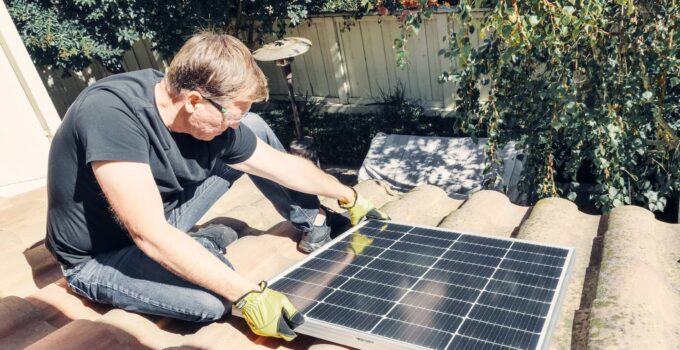The growing demand for solar energy in the US has led to an increased interest in determining the number of solar panels needed to power the entire country. As the world continues to shift towards renewable energy sources, solar power has emerged as a viable and sustainable option for meeting the nation’s energy needs.
In this article, we will delve into the calculations, explore the potential, examine the factors influencing installation, discuss the implications, and highlight the environmental benefits of harnessing solar power at scale.

The Growing Demand for Solar Energy in the US
In recent years, there has been a surge in the demand for solar energy in the US. This can be attributed to several factors, including the increasing awareness of climate change, the desire for energy independence, and the availability of government incentives and subsidies.
As more individuals and businesses recognize the importance of transitioning to clean and renewable energy sources, the demand for solar panels continues to rise.
Calculating the Solar Panel Requirements for the Entire Nation
Calculating the exact number of solar panels needed to power the entire US requires a comprehensive analysis of several factors. These factors include the total energy consumption of the country, the efficiency of solar panels, the average sunlight hours, and the geographical distribution of the population.
By considering these variables, experts can estimate the number of solar panels required to meet the energy demands of the nation.
Exploring the Potential of Solar Power in the US
The potential of solar power in the US is immense. With its vast land area and abundant sunlight, the country has the capacity to generate a significant amount of electricity from solar energy.
According to experts, if the US were to harness just 10% of its solar potential, it could power millions of homes and businesses. This highlights the untapped potential of solar power and the importance of further investment and development in the sector.
Factors Influencing the Installation of Solar Panels across the Country
Several factors influence the installation of solar panels across the country. These factors include the cost of solar panels, government policies and incentives, local regulations, and the availability of sunlight.
The cost of solar panels has significantly decreased over the years, making them more affordable and accessible to a wider range of consumers.
Additionally, government policies and incentives, such as tax credits and net metering, have encouraged individuals and businesses to invest in solar energy systems.
The Implications of Solar Energy on the US Energy Independence
The adoption of solar energy has far-reaching implications for the US energy independence. By reducing reliance on fossil fuels and transitioning to renewable energy sources like solar power, the country can become less dependent on foreign oil and achieve greater energy security.
Solar energy provides a decentralized and sustainable solution for meeting the nation’s energy needs, thereby reducing vulnerability to geopolitical tensions and fluctuations in global oil prices.
The Environmental Benefits of Harnessing Solar Power at Scale
One of the most significant advantages of harnessing solar power at scale is the positive impact it has on the environment. Solar energy is a clean and renewable source of power that produces no greenhouse gas emissions or air pollution during operation.
By replacing traditional energy sources with solar power, the US can reduce its carbon footprint, mitigate climate change, and improve air quality. Additionally, solar energy systems require minimal water usage compared to other forms of electricity generation, further contributing to environmental conservation.
Frequently Asked Questions about How Many Solar Panels Are Needed to Power the US?
Q: How many solar panels are needed to power the entire US?
A: Calculating the exact number of solar panels needed to power the entire US is a complex task. It depends on various factors, including the country’s total energy consumption, the efficiency of solar panels, and the average sunlight hours.
However, experts estimate that to meet the current energy demands of the nation, it would require millions of solar panels.
Q: What is the average energy consumption in the US?
A: The average energy consumption in the US varies depending on various factors, such as the size of the population, economic activities, and climate conditions.
According to the U.S. Energy Information Administration, the total energy consumption in the US was approximately 100 quadrillion British thermal units (Btu) in 2020.
Q: How efficient are solar panels?
A: Solar panel efficiency refers to the amount of sunlight a panel can convert into electricity. The efficiency of solar panels has improved significantly over the years, with the average efficiency ranging between 15% and 20%. However, there are now panels available on the market with efficiencies exceeding 20%.
Expert Advice on How Many Solar Panels Are Needed to Power the US
As the US continues to embrace solar power as a sustainable energy solution, it is crucial to consult with experts in the field to determine the exact number of solar panels needed to power the entire nation.
These experts can conduct detailed assessments, considering factors such as energy consumption, solar panel efficiency, and geographical distribution. By seeking expert advice, individuals, businesses, and policymakers can make informed decisions regarding the installation of solar panels across the country.
In conclusion, the number of solar panels needed to power the US depends on various factors, including energy consumption, solar panel efficiency, and geographical distribution. While it is challenging to provide an exact number, experts estimate that it would require millions of solar panels to meet the current energy demands of the nation.
By harnessing solar power at scale, the US can reduce its reliance on fossil fuels, achieve greater energy independence, and contribute to a cleaner and more sustainable future.






